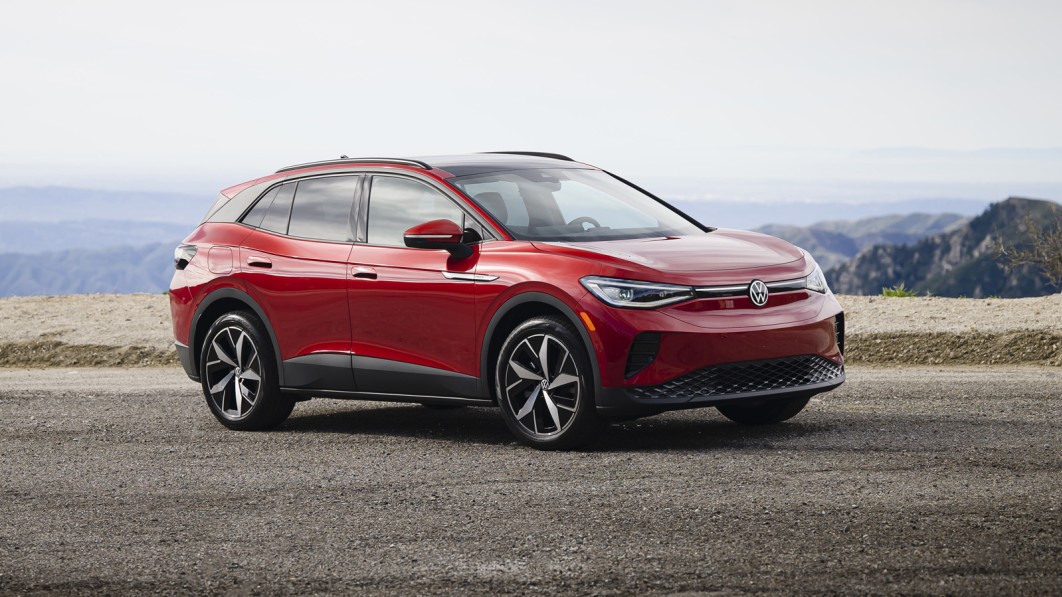
Pros: Reasonable price; more passenger and cargo space than EV rivals; surprisingly deft handling; strong safety ratings; made in America
Cons: Some cheap interior materials; some basic controls still frustrate; slower to charge than some rivals; no one-pedal drive mode
The 2024 Volkswagen ID.4 is a sensible electric SUV that’s roomy, good to drive and reasonably priced. It’s even made in Tennessee and eligible for the $7,500 federal tax credit. Among the growing number of electric crossovers, it makes a lot of sense, and it gets a lot better for 2024 thanks to some substantial upgrades and changes.
First, let’s talk about the upgrades. Those ID.4 models with the bigger 82-kilowatt battery get considerably more power. The rear-wheel-drive, single-motor version now produces 282 horsepower, up from 201 hp, and can go from 0-60 mph in 5.9 seconds. That’s about 2 seconds quicker than last year and is a rapid pace for a single-motor EV. The dual-motor version also jumps up to 335 hp, up from 295. Its 0-60 time falls by almost a second below the 5-second mark. Better still, range improves.
Now, the changes. The ID.4 had been very difficult to recommend because of its frustrating interior controls, including a hopeless, poorly designed infotainment system. For 2024, VW addressed these strong complaints. The touch-operated sliders that control temperature and volume are now illuminated at night, though we’ll never be fans of touch-operated sliders. The rest of the climate controls are now permanently docked at the bottom of the touchscreen, which grows by 0.9 inches. VW also added four menu shortcut buttons at the top of the screen, which can be customized to whichever functions the driver wants readily at hand. Some other functionality elements were also cleaned up, while processing speeds and memory were increased. In total, it’s a better system that’s no longer a deal breaker. We still don’t love the cost-cutting window controls and abundance of hard plastics that really drag down the interior’s sense of quality and overall ambience.
Note, however, that these changes only apply to those ID.4s with the bigger 82-kilowatt battery. There are some that do apply to the 62-kilowatt version, like a new shifter position (it’s now a wheel stalk instead of attached to the instrument panel) and updates to the navigation system that let you set multiple charging stop waypoints on your route. Otherwise, though, the ID.4 is better and more competitive with the bigger battery, even if obviously more expensive. It’s ultimately far easier to recommend the ID.4 for 2024, especially given the federal tax credit that gives it a big leg up over the Hyundai Ioniq 5 and Kia EV6.
Interior & Technology | Passenger & Cargo Space | Performance & Fuel Economy
What it’s like to drive | Pricing & Trim Levels | Crash Ratings & Safety Features
What’s new for 2024?
There are significant changes for 2024, which we detail above.
What are the ID.4 interior and in-car technology like?
The ID.4’s cabin feels spacious and airy, especially with the glass roof. We have mixed feeling about the design. Some editors found it to be sleek, modern and unencumbered. Others find it plain and brought down by an abundance of hard plastic and other unimpressive materials. We all agree that some basic controls continue to be a nuisance. Touch-sensitive climate and volume controls are difficult to use, even if now illuminated at night in 82-kW models. There also aren’t dedicated buttons for the rear windows on the driver door. You have to tap another touch-sensitive “button” to switch the two available toggles between front and rear windows. If the sun is shining, though, you can’t tell if the “REAR” light is illuminated. You also can’t tell if the mirror control toggle has been turned to the Left or Right mirrors. It’s strange, chintzy and annoying.
While the 62-kWh models still use the same slow and poorly organized 12-inch touchscreen infotainment system as in 2023, the 82-kWh models see some significant and welcome tech upgrades, starting with a 12.9-inch display with faster response and easier-to-use menus. It’s highly customizable, with multiple pages and layouts that can display your preferred applications and information. At the top and bottom are fixed function bars. The lower is a dedicated climate menu that’s always accessible, including with controls for the available heated and ventilated seats. The top bar is customizable for shortcuts to your preferred apps and menus. We’re pleased to report that the system is finally quick and responsive, while the various functionality improvements were successful. The satellite radio controls remain frustrating at times (you should be able to see your channel favorites and current music selection at the same time), but, in general, we could live with this system now. We could not before.
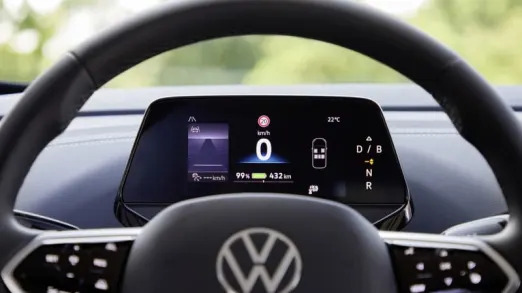

How big is the ID.4?
If you look at the specs, you’ll see the VW ID.4 is right in the middle of the compact crossover bunch. However, its electric architecture makes it a Granny Smith in a basket of Galas. Yes, it’s not as long as a Honda CR-V or Toyota RAV4, for instance, but its wheelbase is considerably longer. That’s best seen in the truly gigantic back seat. We were able to fit an enormous rear-facing Britax Boulevard child seat behind both the passenger and driver seat set for a 6-foot-3 driver. That means you can fit two rear-facing car seats in the back seat, a rarity, while also equating to palatial legroom for big kids and adults. Heck, go ahead and bring along a few basketball players.
Admittedly, the ID.4’s prime electric competitors, the Hyundai Ioniq 5 and Kia EV6, have similarly generous passenger space due to similar architectural reasons. However, the VW is higher off the ground and SUV-like, making loading those kids into their car seats a bit easier. VW also holds a decisive advantage in terms of cargo capacity. It has 30.2 cubic feet of space behind its back seat, which lands it in the middle of the compact SUV pack while blowing away the EV pack. In our ID.4 cargo area luggage test, the ID.4 falls short of mega-carriers like the RAV4 and Hyundai Tucson hybrids, but easily swallowed more stuff than the EV6, Ioniq 5 and Mustang Mach-E.
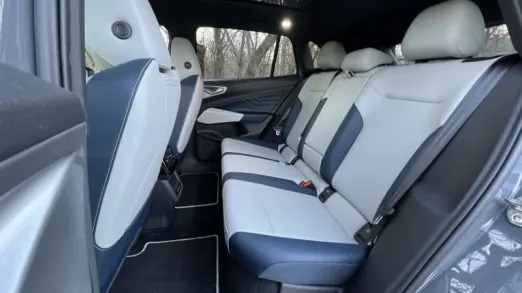
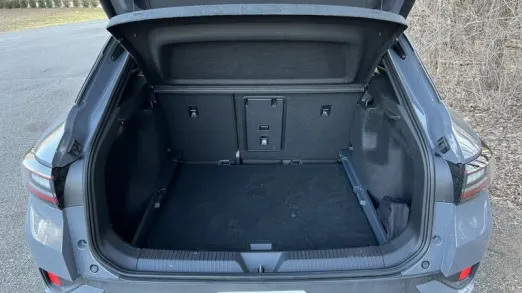
What are the ID.4 fuel economy, performance and electric range specs?
The ID.4 is available with a choice of batteries and either rear- or all-wheel drive, which alter how much performance and range you get. The base ID.4 Standard comes with a 62-kWh battery and a single motor providing rear-wheel drive and 201 horsepower. VW nor the EPA had announced range for the 2024 62-kWh ID.4 at the time of this writing, but we would expect it to be the same 209-mile estimate as in 2023.
Moving up to the 82-kWh hour battery nets you a more powerful rear motor providing 282 horsepower and 402 pound-feet of torque. VW says this motor will get the ID.4 up to a speed in a rapid 5.9 seconds from 0-60 mph. That’s one of the quickest times among single-motor models in this segment, and a big improvement over the old rear-drive ID.4’s time of 7.7 seconds. EPA-estimated range is now 291 miles for the rear-drive ID.4.
Opting for all-wheel drive adds a front motor and a total system output of 335 horsepower. The front motor adds 99 pound-feet, but VW didn’t provide a total system torque figure. Its 0-60 time is now 4.9 seconds, an improvement of nearly a second over last year’s model. Range also improves to 263 miles.
As far as charging, the ID.4 doesn’t do it as quickly as some of its rivals (like Tesla, or the Hyundai/Kia E-GMP vehicles), but it’s not the slowest of the lot, either. The 62-kWh battery can charge at 140 kW, while the 82-kWh versions can do up to 170 kW. In the latter, VW states it can charge from 10-80% in about a half hour. The ID.4 does enjoy the streamlined experience of Plug & Charge at Electrify America stations. As for charging at home or on a public Level 2 charger, the ID.4’s 11-kW onboard charger means the 62-kWh pack can fully charge in 6 hours, 15 minutes, while the bigger pack takes 7.5 hours.

What’s the ID.4 like to drive?
With its significant increase in power and torque for 2024, you no longer have to step up to the dual-motor, all-wheel-drive ID.4 to get zesty performance. We extensively tested a rear-drive 2024 ID.4, and found its highway passing power and performance on a very winding mountain road to be more than enough. It’s now one of the quickest EVs in its segment and feels it. We did not get a chance to drive the improved dual-motor version. If the acceleration figures are to believed, it should be just as quick as a dual-motor Ioniq 5 and EV6, but we also doubt it’ll be such a huge jump that many drivers will care to pay the extra cash and sacrifice range.
As for its ride and handling, the ID.4 continues to impress. It quite clearly sprouted from the European branch of the Volkswagen family tree that spawned the Golf rather than the American one featuring the Tiguan and Taos. The ride is firmer and more controlled, and the steering more immediate and connected in its responses (though still awfully numb). When combined with its ultra-low center of gravity, it all amounts to a surprisingly fun crossover to drive. We actually enjoyed flinging it around a mountain more than the Mustang Mach-E, a result that was just as surprising to us. We did notice quite a bit of stability control intervention with the rear-drive model, though, so don’t expect any sort of tail-out, rear-wheel-drive histrionics from your electric family crossover.
One thing to consider: the ID.4 doesn’t provide a heavy regenerative braking mode that allows for so-called one-pedal driving. It does have “B” mode that results in braking when you lift off the throttle, but the amount is comparable to the “low” modes of other EVs.
What other Volkswagen ID.4 reviews can I read?
2021 Mustang Mach-E vs 2021 Volkswagen ID.4 Comparison Test
We put the two long-range, rear-wheel-drive EVs head to head.
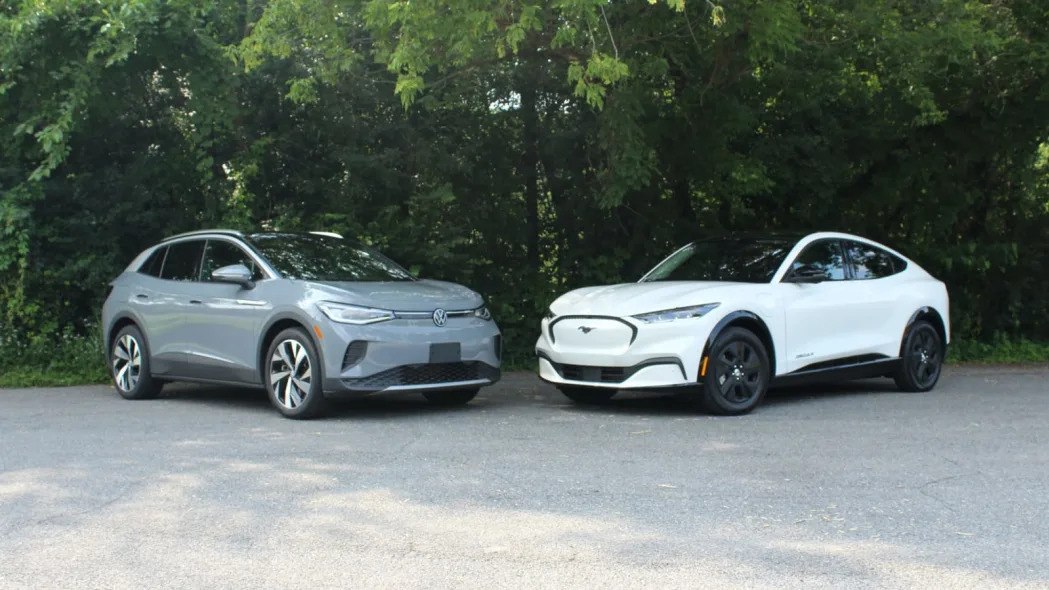
Volkswagen ID.4 Luggage Test | How much cargo space?
Sure, it’s an EV, but it’s also an SUV. How does it do with SUV stuff?
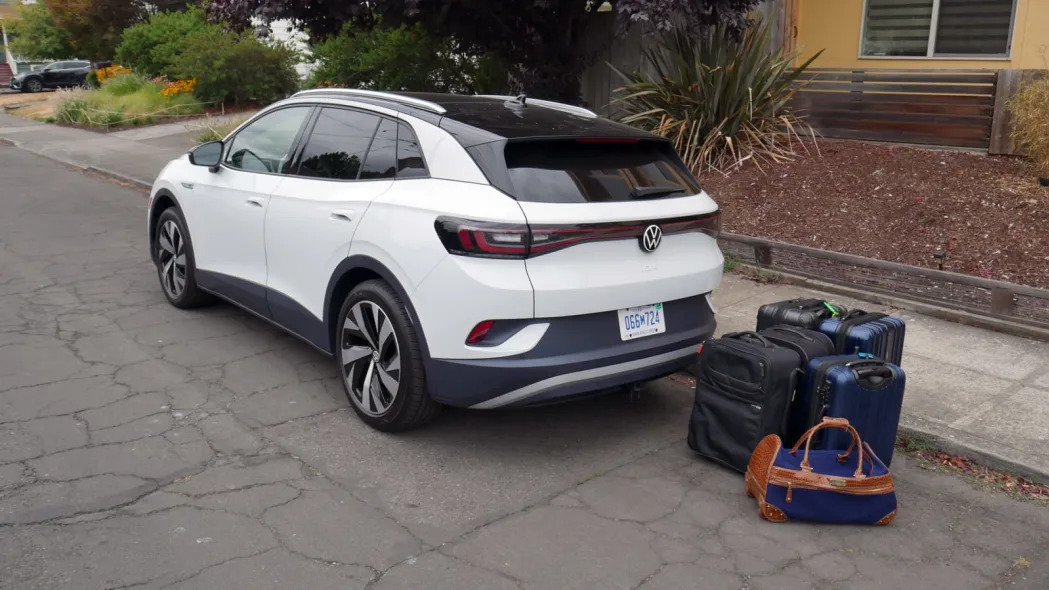
2023 Volkswagen ID.4 Interior Review: The good and the frustrating
We check out the interior of the 2023 ID.4, appreciate its clutter-free environment, and note our frustrations with some of the controls (some of which see improvements for 2024, mind you).
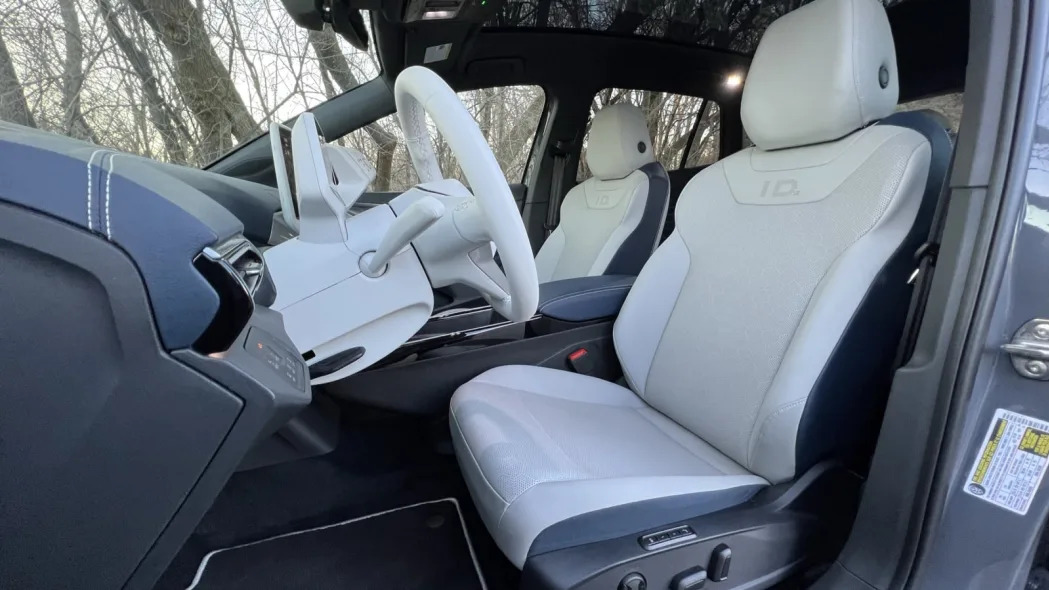
2023 Volkswagen ID.4 First Drive Review: One for the home team
This is our first test of the ID.4 once VW brought production to the USA and made some changes to it.
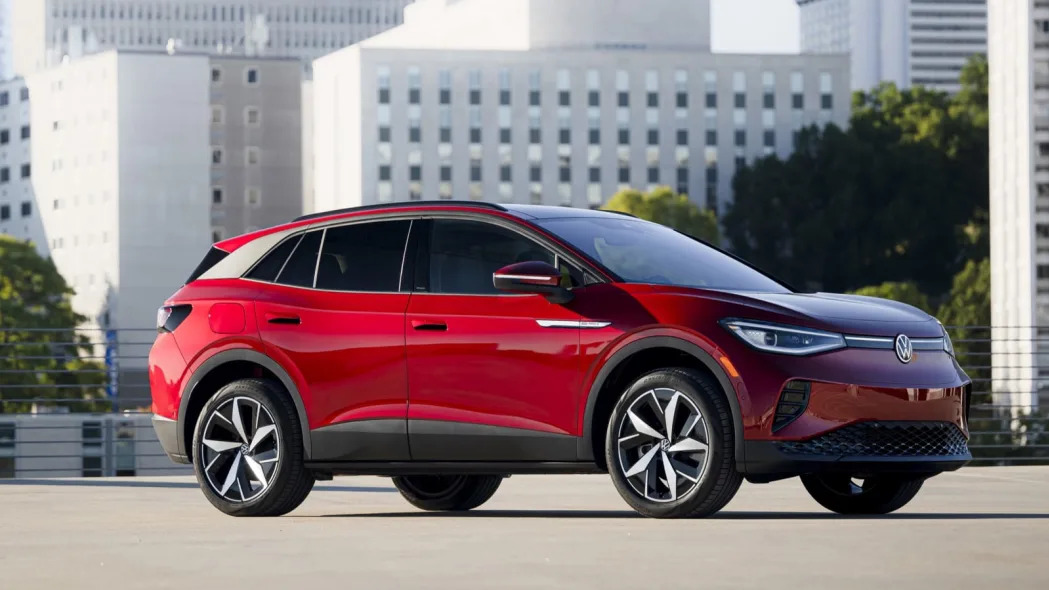
2021 Volkswagen ID.4 First Drive Review | A new electric personality for VW
Mainstream approach seems right, but will it get lost in the shuffle?
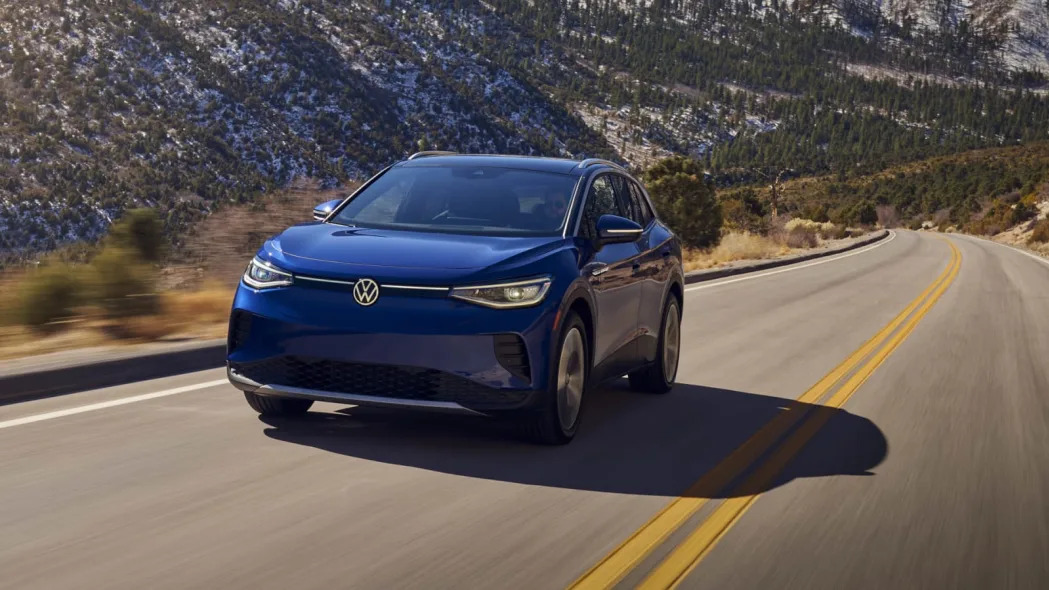
What is the 2024 ID.4’s price?
Volkswagen starts at $41,160 for the 62-kWh battery and $46,300 for the 82-kWh battery. The ID.4 is built at VW’s Chattanooga, Tennessee plant, meaning it’s eligible for the $7,500 federal tax credit.
All prices below include the $1,425 destination charge.
Rear-Motor, 62-kWh Battery
Entry: $41,160
S: $46,280
Rear-Motor, 82-kWh Battery
Pro: $46,300
Pro S: $51,420
Pro S Plus: $54,600
Dual-Motor, 82-kWh Battery
Pro: $50,180
Pro S: $55,300
Pro S Plus: $58,480
What are the ID.4 safety ratings and driver assistance features?
The ID.4 has a full complement of standard active-safety features. Those include forward-collision warning with pedestrian and cyclist detection, automatic emergency braking, adaptive cruise control with stop-and-go capability, lane-keeping assist, blind-spot and rear cross-traffic warning, road-sign recognition and parking sensors.
The 2024 VW ID.4 had not been fully tested by the Insurance Institute for Highway Safety at the time of this writing. It was a Top Safety Pick+ last year, but because the IIHS has changed its criteria for 2024, there is a chance it won’t again. The NHTSA gave the ID.4 perfect five-star crash ratings and a four-star roll-over rating.
Related video:
Credit : Source Post


